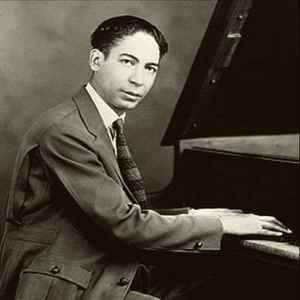Jelly Roll Morton
 In search of the historic origins of jazz, one must pay special attention to Jelly Roll Morton, the self-professed inventor of the genre itself. Morton was born as Ferdinand Joseph La Menthe, his name as multicultural as the city from which he hailed. Morton showed musical promise from a young age. Sources agree that Jelly Roll began to study the guitar at age 7 and piano at age 10, the latter of which became the instrument he was very closely associated with throughout his life1. In 1902, Morton began touring in New Orleans’ Storyville district, the same area where other incredible jazz artists such as Buddy Bolden and Louis Armstrong got their starts. At this time, proto-jazz saw widespread popularity in Southern-Midwestern states such as Illinois after emerging out of Missouri and Mississippi about a decade prior. Despite the practice of jazz in Missouri and Mississippi before Morton became a public figure, Jelly Roll Morton still somewhat selfishly claimed to have birthed jazz in 1902.
In search of the historic origins of jazz, one must pay special attention to Jelly Roll Morton, the self-professed inventor of the genre itself. Morton was born as Ferdinand Joseph La Menthe, his name as multicultural as the city from which he hailed. Morton showed musical promise from a young age. Sources agree that Jelly Roll began to study the guitar at age 7 and piano at age 10, the latter of which became the instrument he was very closely associated with throughout his life1. In 1902, Morton began touring in New Orleans’ Storyville district, the same area where other incredible jazz artists such as Buddy Bolden and Louis Armstrong got their starts. At this time, proto-jazz saw widespread popularity in Southern-Midwestern states such as Illinois after emerging out of Missouri and Mississippi about a decade prior. Despite the practice of jazz in Missouri and Mississippi before Morton became a public figure, Jelly Roll Morton still somewhat selfishly claimed to have birthed jazz in 1902.
Although Jelly Roll Morton was undisputedly an amazing jazz musician, he wasn’t only known for his musical talents. A series of interviews which introduce the novel Kings of Jazz: Jelly Roll Morton by Martin Williams also describe him as a “pimp,” a “pool shark,” and “a man looking for easy money.” Some interviewees didn’t even know that he played piano. While Jelly Roll Morton’s personal life involved some questionable hobbies, his piano playing overshadowed his bad reputation and suspicious activities. People listened2.
Jelly Roll left Louisiana a few years later in the hopes of expanding his success and pursuing music further North in the United States. From 1905-1909, Morton played shows in Detroit, Michigan; Philadelphia, Pennsylvania; St. Louis, Missouri; and Chicago, Illinois. He found positions as music director of Richelieu Cafe as well as manager of Chicago’s Elite No. 2 Cabaret and the Fairfax hotel. Morton traveled with the growing jazz scene and moved to New York where he was discovered by James P. Johnson, another well-known jazz pianist at the time. Morton then toured the Black Vaudeville circuit between 1911 and 1914, playing in more Southern venues such as Mobile, Alabama and Memphis, Tennessee. After continuing to explore the Vaudeville circuit and other venues until 1917, Morton moved to Los Angeles, California where he worked under the management of a woman named Anita Gonzalez at the Cadillac Cafe for 5 years from 1917-1922. These years were spent constantly hustling and playing, either solo repertoire or with less-experienced jazz artists3.
Jelly Roll then moved to Chicago, Illinois in 1922, where he discovered a sheet music industry ready to take off. Eager to take advantage of the opportunity and equipped with his mental inventory of jazz repertoire, Morton struck a deal with Walter Melrose of Melrose Publishing to have his works recorded by Victor Recording Company. These recordings of Morton’s propelled Melrose publishing to the top of the industry. In what became Melrose’s most successful group, Jelly Roll Morton and the Red Hot Peppers pioneered a new form of jazz music between 1926 and 1927. The group played ensemble sections composed by Morton intermixed with improvisatory solo sections that shone the spotlight on individual ensemble members. Jelly Roll was a strict and demanding jazz leader, expecting nothing less than perfection from his band and therefore exalting his group to new heights of expressive and technical jazz musicality than ever seen before in American history4.
In 1928, Morton brought a reformed Hot Chili Peppers band back to New York where he recorded over 50 songs. Also in New York, Morton met a dancer named Mabel Bertrand who became his common-law wife. In 1938, ethnomusicologist Alan Lomax recorded 8 hours of Jelly Roll’s music for the Library of Congress as documentation of one of the greatest jazz artists to ever live. Morton tragically had a heart attack in 1939 and moved back to California with his wife before dying in 19415.
Jelly Roll Morton’s recordings made for the Library of Congress—along with Morton’s own declaration of himself as the first person to ever play jazz music–make him one of our research group’s most important case studies in searching for the spread of early jazz. In one instance, Jelly Roll crossed paths with Joe “King” Oliver in 1923 when his song “Froggie Moors” was first recorded by King Oliver’s Creole Jazz Band. This collaboration, along with his numerous other rendezvous with jazz musicians, proves that Jelly Roll Morton was not just simply an influential figure within jazz music as a genre in the way that he made his own popular music but also in how he wrote music for and influenced other prominent musicians of the time period.
You must be logged in to post a comment.